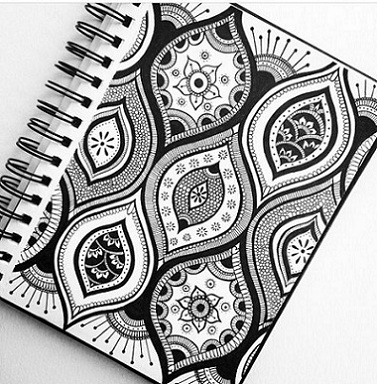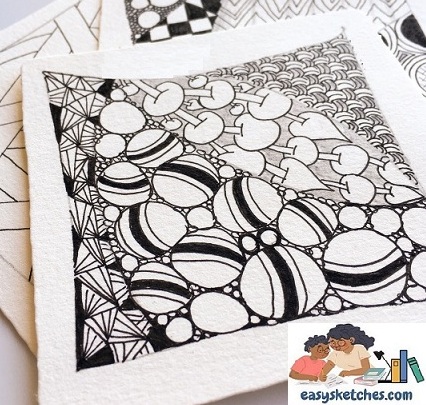Products You May Like
Want to start Doodling but are frustrated and confused with doodling styles, and what is the difference? In this post, I will look at the different types of doodling (or repetitive forms of art) and discuss what makes them different.

There are five main styles or forms of doodle-based art that are:
- Zentangle
- Zen doodling
- Stendoodling
- Mandalas as well
- Doodle Art
Each style or style has its specific features and forms, and everything is equally good! Let’s look at each one and see what they’re about and what makes them different. (5 Doodling Styles)
Zentangle
Zentangle.com describes Zentangle “as an easy-to-learn, relaxing, and fun way to create beautiful images by drawing organized patterns.
Zentangles are based on:
Focus – each side is done intentionally (even if the result is confusing)
No Eraser – work out your errors in your build
Basics (or restrictions) on the use of ‘strings.’
Abstract – nothing up or down, which should not – that is: should not look ‘is.’
Festival – similar to the Japanese tea festival of concept!
Zentangles are made of 3.5 “small square tiles” and are made based on ‘strings’ used to describe areas filled with ‘Tangles’ (repetitive patterns).
Zentangle is called ‘binding’ and is a form of meditation technique in which the artist focuses on creating each line rather than a specific image. Zentangle, but rather Zentangle Inspired Art (ZIA) or Zendoodle.
These are some of the Zentangles I’ve created; as you can see, they don’t look like ‘something,’ no top or bottom, black and white with some dimming, using tangle patterns that are named and most importantly created and maintained, intentionally and focused on the process.
Zen doodling
Zendoodling is based on Zentangling and shares many similar features – focus, construction, repetitive patterns of capture. It can be in color, on any paper size, specific shape (e.g., name, letter, animal), and up and down.
Think of Zendoodle or Zentangle Inspired Art (ZIA) as using the same or similar tangle patterns to create an image, but with Zendoodling, you can draw a leaf frame and fill it with tangle patterns, you can add tangles to an image or 3D object.
Zendoodling is very similar to Zentangling – with the same patterns of repetition and reflection but without limits in texture, size, or color. (5 Doodling Styles)
This is one of my favorite Zen doodles. It’s part of an art book page. It makes a background, is designed to look like something (which makes it a Zendoodle rather than a Zentangle), and is certainly created in a meditative way, filling in all the little things I had taken hours.
If you want to see how I have included Zendoodling on my art books page, you can check it out here.
Zendoodle as part of a book page
Stendoodling
Stendoodling uses stencils to create an image frame, interior design patterns, and individual doodle patterns!
Creating a Stendoodle:
Use a stencil or mask to create a shape (e.g., feather),
Then use another stencil to produce parts within that type (e.g., sunlight), and finally,
Use small stencils (and an excellent marker) to create patterns within each section.
Michael Trent makes this beautiful art form, a Brazilian artist – see the beginning and end example and learn more about it here. (5 Doodling Styles)
I love Stendoodling; as anyone can do this, you don’t have to be able to ‘draw’ anything or a doodle; you just need to be able to track a pattern or shape! For artists who already have paper stencils or masks, looking for a very stressful job – but not happy with adult coloring books, so this might be good for you!
This is still my favorite Stendoodled project – I have combined Stendoodles with free-hand doodle art to create this lady in beautiful masks.
Mandalas
The word Mandala (pronounced mon- dah-lah) is a Sanskrit word meaning “circle” and is the oldest tradition practiced by many cultures and religions (Buddhists, Hindus, Native Americans, Christians, etc.).
Traditionally used in meditation or as a spiritual tool to represent universal connection, mandalas are now used to encourage thinking and relaxation. Making Mandala can soothe and help focus the mind.
Although it usually consists of circles within the squares, the Mandalas can be of any shape, but they MUST be an integrated structure arranged around the connecting center. (5 Doodling Styles)
Mandalas consist of repetitive geometric patterns, which work from the center to the outside, are usually colored, and can be very simple or complex.
Mandalas are created with a purpose in mind, e.g., perfection, connection, purpose; the creator must focus on their goal as he draws.
The creator may feel like using certain words, shapes, or patterns while drawing; let it flow. The Mandala ends when you feel complete or when you have lost focus.
This list of colors and their symbolic meanings help you make mandala color choices, or you may want to choose colors for your favorite moments and see what they can mean. Maybe you are drawn to specific colors.
